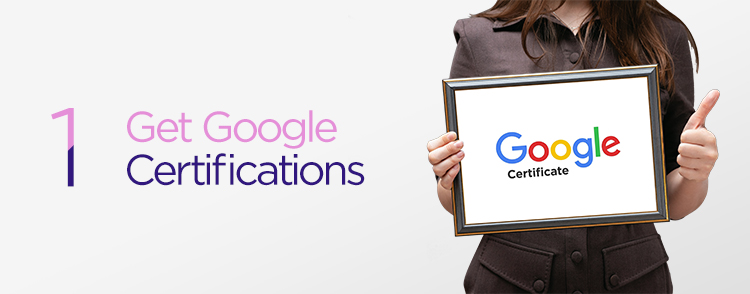If you are a fresh graduate or mid-careerist looking to build a career in digital marketing, here is a five-step guide for you to get started.

Google has free courses to help you gain the necessary skills, and also provides certification that demonstrates to clients or future employers that you possess the required skills.
- Fundamentals of Digital Marketing: A free and basic digital marketing online course for anyone who wants to gain a complete understanding of all aspects of digital marketing.
- Google Analytics for Beginners: Google Analytics is a free web analytics tool that helps one better understand traffic flow on websites. This course will teach you how to use Google Analytics data and insights to create data-driven marketing decisions.
- Google Ads Certification: This programme certifies users as online advertising experts who can create effective Display strategies and campaigns to meet specific marketing objectives.
Looking for a marketing role? Explore available marketing positions right now on MyCareersFuture.

Social media has grown into a powerful and vital virtual space that is used not only for social networking but also as a powerful tool for digitally promoting businesses and products. A comprehensive and integrated marketing strategy must include a mix of social media platforms to reach out to target audiences.
These are some of the most widely used platforms for brand building and marketing.
- Facebook: Creating a Facebook Business Fan Page is an excellent place to start. People mostly go to Facebook to unwind and speak with friends, so stay light and friendly in your posts. The reach on Facebook organic posts may be limited, hence using a cost-effective Facebook ad strategy is recommended.
- Instagram: Instagram started as a photo-sharing site, and still serves that purpose today. In a feature known as “stories,” it has grown to include videos. As a result, Instagram has become a fantastic platform for firms to show (rather than explain) their products, values, and personality. Instagram is also a part of the ad network on Facebook – when you create Facebook ads, you may also display them on Instagram.
Tiktok: With over 500 million users worldwide, TikTok is gaining in popularity. Many marketers are beginning to see the advantages of using the app to promote a product or service, as it offers a diverse range of advertising opportunities.

CMS, short for Content Management System, is a software tool for creating and managing websites even without coding knowledge. You can create, manage, revise, and publish information with a CMS in a user-friendly interface. Rather than coding, you can download or purchase templates and plugins to personalise the look and functionality of your website. These platforms, like WordPress, allow you to create a wide variety of websites, from blogging to e-commerce to business and portfolio sites.

Advertising aims to inform, educate, persuade, and remind people about your product or service. One crucial advertisement strategy is Web copywriting, which refers to the choice of words that marketers employ to convince their audience to take action after reading or hearing them.
There are four stages involved in enticing an audience to take action or make a purchase.
Awareness: The first step in marketing is to grab customer’s attention. Start by asking yourself these questions. How can we inform buyers about our products or services? What platforms or tools are we using? What should be the message and most critical issue to address for potential customers? Attractive banners with powerful visuals and copy will make them want to stop and read. Use strong words and concentrate on individual elements to guide them to the next stage.
Interest: Once you grab their attention, keep them interested and intrigue them with your unique selling proposition. Considering how short online attention spans can be, especially on mobile, you must know how to keep up your offers.
Desire: Here, you must take the potential customers from “liking” to “wanting”. Ask yourself: what makes our product or service desirable? How do we evoke an emotional connection through our messages? One approach would be using online chats via your website or Facebook page to provide advice or suggestions. Personalise your online text to make it appear as if you’re speaking directly to them, to help both parties create trust and transparency.
Action: The final step is encouraging your customer to take action. Place your call-to-action texts at the right marketing channels (emails, your website, landing pages, inbound phone calls, etc.) to ensure conversion. Make the call-to-action texts personal and relevant to the product or service you’re selling, and simple enough for customers to connect with. Accompanying strategic placement with captivating language will better persuade your target audience to engage and buy from you.

An autoresponder software sends out automated emails to your subscribers when they sign up for your newsletter, or when a trigger event occurs. The key goal is to keep in touch with your audience via a series of follow-up communications once they interact with your business digitally. An autoresponder software helps you to:
- Send important messages to subscribers
- Move leads through the marketing funnel
- Send customised messages to specified email list segments
- Analyse data to increase sales and improve engagement and upsells
Remember that receiving a marketing job offer is only the beginning — your next goal is to keep learning and staying updated on the latest industry trends in the dynamic landscape of digital marketing. Once you’ve started your role, keep the following factors in mind:
- You may not be able to apply what you learnt about marketing to your everyday tasks
- Keep an eye on deadlines and meet expectations as soon as possible, as the marketing world is fast-paced
- Don’t be afraid to take initiative and volunteer for extra responsibilities as they arise.
- And lastly, don’t be afraid to reach out for help from those in the team who are more experienced.
This article is contributed by Verz Design.














